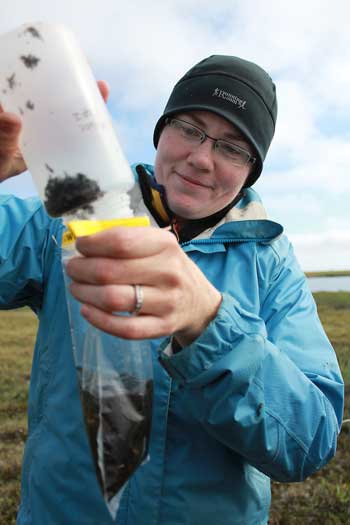
By Crystal Ernst
June 16 – The small twin-propeller plane bursts through the clouds and begins its final descent. As we approach the gravel landing strip in Kugluktuk, Nunavut, the northern community that will be my summer home, I catch my first-ever glimpse of the arctic tundra. From the air, the land below seems barren: flat, cold, dull, grey. I feel very far away from my comfortable life in the south and the familiar verdant cosiness of the towering maple and elm trees growing in my front yard.
June 19 – Was I ever wrong about this place. It is breathtakingly beautiful. The tundra is blanketed with a fireworks display of colourful flowers. Soaring sandy hillsides plunge dizzyingly towards the blue waters of the mighty Coppermine River. Pinkish basalt cliffs jut high above the land, adorned in dazzling orange and yellow lichens. The sky is unobstructed and stretches on for an eternity; it is the perfect canvas for the sun that hangs low and fiery over the ocean at midnight. Every time I think I’ve seen the best view, I am treated to another wondrous eyeful.
July 21 – It’s the first sunny day after a long week of rain and cloudy skies. A short while ago I finished laying out some spare yellow pan traps amongst the sedges and dwarf willows growing on a wet stretch of tight-packed sand south of town. Now, I’m perched on a narrow grassy ledge halfway up the side of a 150-foot cliff, looking out over the wide mouth of the river. Although I’ve paused to appreciate the view, I am here with a particular target in mind. Today, I am hunting wasps.
As a team member of the Northern Biodiversity Program (www.northerbiodiversity.com), I am tasked with collecting insects and other arthropods from the land and waters surrounding this remote oceanside hamlet for eight weeks. Several times a week I steer my ATV over the rough, hummocky terrain, eventually abandoning the well-travelled hunting trails used by local residents in favour of more secluded areas. I harvest six- and eight-legged specimens from over 100 traps that have been carefully laid out as part of our team’s standardized collection protocol. The same traps and techniques are being deployed by students and researchers from three universities (McGill, Toronto, PEI) in 12 localities across northern Canada over the next two years. This ambitious project hopes to uncover the effects of climate change on arctic ecosystems over the past half-century, by comparing current insect communities to those documented by the Canadian Northern Insect Survey. Insects, being incredibly sensitive to changes in their environment, are excellent natural indicators of ecological change.
When traps do not require my immediate attention, I scour the land for interesting microhabitats which could yield unique or uncommon species. Pebbly mud flats next to the river. Dune-like sand hills dotted with unusually tall shrubs. Freshwater beaches loaded with fuchsia Dwarf Fireweed and yellow Marsh Saxifrage. Or, like today, the tallest basalt cliff I could find.
I first clambered over huge chunks of rocks that had cleaved from the cliff face and now lie at the base of the towering stone wall. In the large crevices between the chunks I found orb-weaving spiders for the first time; the plump grey and black arachnids were plucked and dropped into a vial of ethanol using the forceps I wear hanging from a lanyard around my neck. I then slipped my way up a near-vertical slope covered in loose, paper-thin sheets of stone, pausing every so often to snare a few flies with my aspirator. My noisy ascent disturbed a nesting pair of rough-legged hawks who circled and screamed plaintively overhead. I edged my way along a lightly vegetated outcrop, being careful where I put my hands; Prickly Saxifrage is the most common plant clinging to life on these rocks, and they painfully live up to their name. I note mud-daubed cliff swallow nests overhead and then, finally, I spot what I came here to find. Last week, a Kugluktummiut recounted how he’d come across wasp nests on these cliffs as a teenager, and now I have one in my sights. The paper nest is several shades of light grey, shaped like an apple with a small round opening at the bottom. Its top is fused to the underside of an outcrop of rock. I watch it from a safe distance for some time. It seems to be vacant; no insects have left or entered the nest. I decide to collect it.
Five minutes later, I’m at the bottom of the cliff, catching my breath and waiting for my pounding heart to settle. After a few gentle pokes with the handle of my aerial net the nest was still firmly attached to the rock. A firmer nudge unleashed a stream of buzzing ivory-and-black-striped wasps, which sent me careening downhill at a pace much faster than I would have liked.
The good news: a quick swat at the buzzing mass landed one wasp in my net, which I was able to keep secured until I safely reached the bottom and could slip it into a killing jar. Harassing the nest was foolhardy, perhaps, but at least I got my specimen.
Crystal Ernst is a PhD Entomology student in McGill’s Department of Natural Resource Sciences and a member of the Northern Biodiversity Program team.
